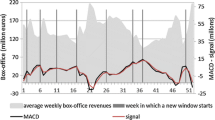Abstract
The paper provides an empirical analysis of box office performance for movies produced in Italy between 1985 and 1996. Descriptive evidence documents a decrease in the total number of films produced and a sharp reduction in daily revenues and per screen daily admissions during the sample period. In the econometric analysis various alternative hypotheses on the impact of the ex ante popularity of directors and cast of actors on box office performances are rejected in favour of a quadratic specification with positive externalities between the two factors. The econometric cross-sectional evidence also documents that the net impact of subsidies on total admissions is irrelevant and that the significantly lower performance of subsidised films depends on the lower ex ante popularity of their cast and directors. Results on the impact of specialisation genres and production houses show that very few of them (i.e., the comic specialisation genre and the Filmauro production house) have a significant marginal impact on box office performances after controlling director and actors effects.
Similar content being viewed by others
References
Bagella, M., 1997, “Economia e Finanza dell'Industria Cinematografica”. Mimeo.
Bagella, M. and Becchetti, L. (1995) “The Buy-Out Property Right Share Choice in Film Financing: Financial Rationing, Adverse Selection and the Bayesian Dilemma”. Journal of Cultural Economics 19: 279–304.
Baumol, W.J. and Bowen, W.G. (1976) “Arguments for Public Support of the Performing Arts”, in M. Blaug (ed.), The Economics of the Arts, Martin Robertson and Company.
Blaug, M. and King, K. (1976) “Does the Art Council Know What it is Doing?”, in M. Blaug (ed.), The Economics of the Arts, Martin Robertson and Company.
Cameron, S. (1986) “The Supply and Demand for Cinema Tickets: Some U.K. Evidence”. Journal of Cultural Economics 10.
Campari, R. (1983) Il Racconto del Film: Generi, Personaggi, Immagini. Laterza, Bari.
Clare, Smith, and Thomas (1997) “U.K. Stock Returns and Robust Tests of Mean-Variance Efficiency”. Journal of Banking and Finance, 641–660.
Chung, K.H. and Cox, R.A.K. (1994) “A Stochastic Model of Superstardom: An Application of the Yule Distribution”. Review of Economics and Statistics 76(4): 771–775.
CSC (Centro Studi Cinematografici) (1981) Come si Legge un Film: Introduzione Critica ai Generi e ai Fenomeni Cinematografici. CSC ed., Roma.
Davidson, Russell and MacKinnon, James G. (1993) Estimation and Inference in Econometrics. Oxford University Press.
Della Fornace, L. (1981) Come si Legge un Film: Introduzione Critica ai Generi e ai Filoni Cinematografici. Bulzoni.
De Vany, A.S. and Walls, A. (1997) “The Market for Motion Pictures: Rank, Revenue and Survival”. Economic Inquiry 35(4): 783–797.
Dexter, A.S., Levi, M.D., and Nault, B.R. (1993) “Freely Determined versus Regulated Prices: Implications for the Measured Link between Money and Inflation”. Journal-of-Money,-Credit, and–Banking 25(2): 222–230.
Efron, B. and Tbishirani, R. (1986) “Bootstrap Measures for Standard Errors, Confidence Intervals and Other Measures of Statistical Accuracy”. Statistical Science 1: 54–77.
Fearne, A. (1989) “The CAP in 1995 – A Qualitative Approach to Policy Forecasting”. European-Review of Agricultural-Economics 16(1): 113–127.
Finn, A., Hoskins, C., and McFadyen, S. (1996) “Telefilm Canada Investment in Feature Films: Empirical Foundations for Public Policy”. Canadian Public Policy 22(2): 151–161.
Gould, W.W. (1992) “Quantile Regressions with Bootstrapped Standard Errors”. Stata Technical Bulletin 9: 19–21.
Grazzini, G. (1980) Le Mille Parole del Cinema. Laterza, Bari.
Hamlen, W.A. (1991) “Superstardom in Popular Music: Empirical Evidence”. Review of Economics and Statistics 73(4): 729–733.
Hamlen, W.A. (1994) “Variety and Superstardom in Popular Music”. Economic Inquiry 32(3): 395–406.
Hansen, L. (1982) “Large Sample Properties of Generalised Methods of Moments Estimators”. Econometrica 50: 1029–1054.
Hansen, L. and Singleton, K. (1982) “Generalised Instrumental Variables Estimation in Non-Linear Rational Expectations Models”. Econometrica 50: 1269–1286.
Heilbrun, J. and Gray, C.M. (1993) The Economics of Art and Culture: An American Perspective. Cambridge University Press.
Hwang, C.L. and Ming, J. (1987) Group Decision Making under Multiple Criteria: Methods and Applications Lecture Notes in Economics and Mathematical Systems Series, Vol. 281, p. 400, Springer, New York, Berlin, London, and Tokyo.
Koenker, R. and Basset, G. (1982) “Robust Tests for Heteroskedasticity Based on Regression Quantiles”. Econometrica 50: 43–61.
McKinlay, C. and Richardson (1991) “Using Generalised Method of Moments to Test Mean-Variance Efficiency”. Journal of Finance 46(2): 511–527.
Miller, M. (1993) “Enhancing Regional Analysis with the Delphi Method”. Review of Regional Studies 23(2): 191–212.
Mooney, C.Z. and Duval, R. (1993) Bootstrapping: A Nonparametric Approach to Statistical Inference. Sage Publications, Newbury Park, CA.
Newey, Whitney and West, Kenneth (1994) “Automatic Lag Selection in Covariance Matrix Estimation”. Review of Economic Studies 61: 631–653.
Prag, J.J. and Casavant, J. (1994) “An Empirical Study of Determinant of Revenues and Marketing Expenditures in the Motion Picture Industry”. Journal of Cultural Economics 18(3): 217–235.
Prat, G. (1996) “Experts' Expected Stock Return and the Valuation Model in U.S.”. Revue-Economique 47(1): 85–110.
Rosen, S. (1981) “The Economics of Superstars”. American Economic Review 71(5): 845–858.
Rogers, W.H. (1993) “Calculation of Quantile Regression Standard Errors”. Stata Technical Bulletin 13: 18–19.
Sesti, M. (1996) La Scuola Cinematografica Italiana. Marsilio Editore.
Scitovsky, T. (1976) “What' Wrong with the Arts is What is Wrong with Society”, in M. Blaug (ed.), The Economics of the Arts, Martin Robertson and Company.
Smith, S.P. and Smith, V. (1986) “Successful Movies: A Preliminary Empirical Analysis”. Applied Economics 18(5): 501–507.
Vogel, H.L. (1994) Entertainment Industry Economics. A Guide for Financial Analysis. Cambridge University Press.
Wallace, W.T., Seigerman, A., and Holbrook, M. (1993) “The Role of Actors and Actresses in the Success of Films: How Much Is a Movie Star Worth?”. Journal of Cultural-Economics 17(1): 1–27.
Wright, G. and Ayton, P. (1987) Judgmental Forecasting. Wiley, Chichester, New York, Brisbane, and Toronto.
Author information
Authors and Affiliations
Rights and permissions
About this article
Cite this article
Bagella, M., Becchetti, L. The Determinants of Motion Picture Box Office Performance: Evidence from Movies Produced in Italy. Journal of Cultural Economics 23, 237–256 (1999). https://doi.org/10.1023/A:1007579421768
Issue Date:
DOI: https://doi.org/10.1023/A:1007579421768




